Vermi compost is nothing but the excreta of earthworms which is rich in humus. We can rear earthworms artificially in a brick tank or near the stem/trunk of trees (specially horticultural trees). By feeding these earthworms with bio-mass and watering properly the food (bio-mass) of earthworms, we can produce the required quantities of Vermi compost.
Advantage of Vermi compost
- Vermi compost is rich in all essential plant
- Provides excellent effect on overall plant growth, encourages the growth of new shoots/leaves and improves the quality and self life of the
- Vermi compost is free flowing, easy to apply, handle and store and does not have bad
- It improves soil structure, texture, aeration, water holding capacity & prevent soil
- Vermi compost is rich in beneficial micro-flora such N-fixers, Psolubilizers, cellulose decomposing micro-flora,
- It nutrilize the soil pH
- It prevents nutrient losses & increase the nutrient use efficiency of chemical
- Vermi compost is free from toxic elements, pathogen, weed seeds
- Vermi compost minimize the pest & disease incidence
- Vermi compost enhance the decomposition of organic matter in
Nutrient content of Vermi compost
| Nitrogen | 1.5 – 2.5% |
| Phosphorus | 0.9 -1.7% |
| Potash | 1.5 – 2.4% |
| Calcium | 0.5 -1.0% |
| Magnesium | 0.2 – 0.3% |
| Sulphur | 0.4 – 0.5% |
And other micro-nutrients with vitamins, enzymes and hormones.
N.P.K content in basic manures
|
Element |
Vermi compost | Farmyard manure |
Bacterial compost |
|
N (%) |
2.1 – 2.6 | 1.1 – 1.5 | 1.2 – 1.5 |
|
P (%) |
1.5 – 1.7 | 0.7 – 0.8 |
0.7 – 0.9 |
| K (%) | 1.4 – 1.6 | 0.6 – 0.7 |
0.6 – 0.7 |
Materials for preparation of Vermicompost
Any types of Bio-degradable wastes:
- Crop residues
- weed bio-mass
- Vegetable waste
- Leaf litter
- Hotel refuse
- Wastes from Agro-Industries
- Bio-degradable portion of urban and rural wastes
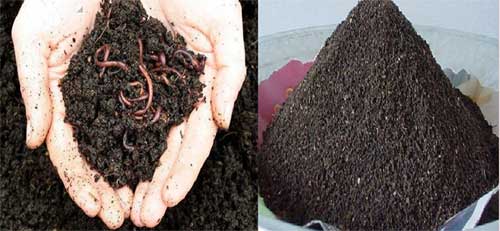
Efficient Species
- Eisenia foetida
- Eddrillus eugineae
- Amyanthes differigens
Vermi compost preparation
Basic raw material: Any organic material generated in the farm like bhusa, leaf fall etc., Horse dung, due to the risk of Tetanus virus, lethal to human beings is not advisable to be used as feeding material for earthworms. Paddy husk, merigold and pine needles have also not advised to be used as feeding materials for earthworms.
Starter: Cow dung , Biogas slurry, or urine of cattle
Soil animal: Earth worms (Species: Eisenia foetida)
Thatched roof/vermished
Favorable conditions of earth worms in the composting material
- pH: Range between 6.5 and 5
- Moisture: 60-70% of the moisture below and above
- Range mortality of worms taking place
- Aeration: 50% aeration from the total pore space
- Temperature: Range between 180C to 350C
Procedure
It is mostly prepared in either pit or heap method. The dimensions either heap or pit are 10 x 4 x 2 feet. The length and width can be increased or decreased depending on the availability of material but not the depth because the earthworms’ activity is confined to 2 feet depth only. First of all select a site which is not under any economic use and is shady and there is no water stagnation. The site should be near to a water source.
1st layer: bedding material of 1″ thick with soft leaves
2nd layer: 9″ thick organic residue layer finely chaffed material
3rd layer: Dung + water equal mixture of 2″ layer.
Continue the layer up to pile to ground level in the case of pit method and up to 2‘ in heap or surface bed method. Protect the worms against natural enemies like ants, lizards, snakes, frogs, toads etc., Maintain proper moisture and temperature by turnings and subsequent staking. At the day of 24th, 4000 worms are introduced in to the pit [1 square m =2000 worms] without disturbing the pit by regular watering the entire raw material will be turned into the vermicompost in the form of worm excreta. The turnover of the compost is 75% [the total material accommodated in the pit is 1000 kg; the out turn will be 750 kg]
Harvesting of the vermicompost from the pit
- Stop watering before one week of
- Sometimes the worms spread across the pit come in close and penetrate each other in the form of ball in 2 or 3
- Heap the compost by removing the balls and place them in a However, under most instances, top layer has to be disturbed manually. Earthworms move downward and compost is separated. After collection of compost from top layers, feed material is again replenished and composting process is rescheduled.
- The material is sieved in 2 mm sieve, the material passed through the sieve is called as vermicompost which is stored in a polythene bags
- Recomposting is done in the same pit or bed. Similar to the above described pit/heap method, vermicompost can be prepared in wooden box or brick column in similar
- In-situ vermicomposting can be done by direct field application of vermicompost at 5 t/ha followed by application of cowdung (2.5 cm thick layer) and then a layer of available farm waste about 15 cm Irrigation should be done at an interval of 15 days.
Precautions
- Do not cover vermicompost beds/heaps with plastic sheets because it may trap heat and gases.
- Do not overload the vermicompost heap to avoid high temperature that adversely affect their
- Dry conditions kill the worms and waterlogging drive them Watering should be done daily in summer and every third day in rainy and winter season.
- Addition of higher quantities of acid rich substances such as tomatoes and citrus wastes should be
- Make a drainage channel around the heap to avoid stagnation of water particularly in high rainfall areas in rainy
- Organic materials used for composting should be free from non-degradable materials such as stones, glass pieces, plastics, ceramic tubes/bulbs
Natural enemies and their control
- The important natual enemies of vermiculture are
- Ants,
- Termites,
- Centipedes,
- Rats,
- Pigs,
- Birds etc.
- Preventive measures include treating of the site with 4% neem based insecticide before filling the
Application rate
It can be applied in any crop at any stage, but it would be more beneficial if mixed in soil after broadcasting. The rate of application is as
- Field crops 5-6 t/ha;
- Vegetables 10-12 t/ha;
- Flower plants 100-200 g/sq ft;
- Fruit trees 5-10 kg/tree.
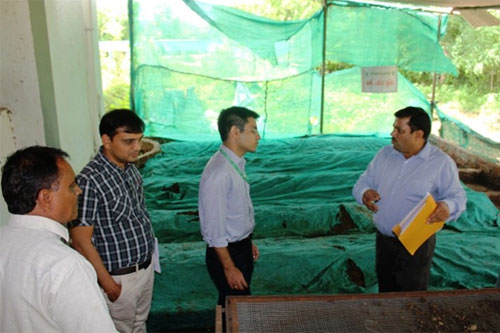
Advantage of vermicompost
- Vermicompost is a rich source of nutrients, vitamins, enzymes, antibiotics and growth hormones. So it gives disease resistance to Nutrient content of vermicompost is higher than traditional composts. It is a valuable soil amendment.
- Vermicompost horbours certain microbial populations that help in N fixation and P solubilization. Its application enhances nodulation in legumes and symbiotic mycorrhizal associations with the
- Superiority of vermicompost over other synthetic growth media is more pronounced in plant nurseries. It can be used as rooting medium and for establishment of saplings in
- It improves taste, lusture and keeping quality of the
- It has immobilized enzymes like protease, lipase, amylase, cellulase and chitinese which keep on their function of biodegradation of agricultural residues in the soil so that further microbial attack is speeded
- It does not have foul odour as is associated with manures and decaying organic wastes.

Vermiwash- A plant growth regulator
Vermiwash is a liquid plant growth regulator which contains high amount of enzymes, vitamins and hormones like auxins, gibberellins etc. along with macro and micro-nutrients.
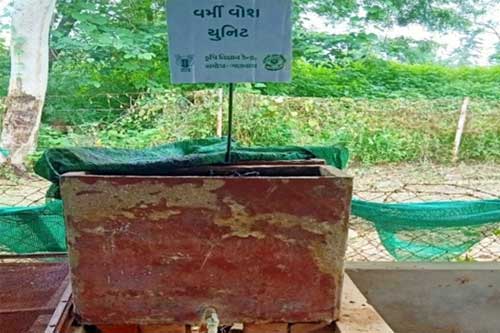
Method of preparation
- Take one big bucket and one
- Set up one stopcock on the lower most part of the
- Put a layer of broken brick pieces of stones having thickness of 10-15 cm in the
- Over this layer put another layer of sand having thickness of 10-15
- Then put a layer partially decomposed cow dung having 30-45 cm thickness over it.
- Then put another layer of soil having 2-3 cm
- Now open the stop cock of the bucket and water the materials taken in the
- Then put 100-200 nos. of earthworms in the
- After that, a layer of paddy straw having 6 cm thickness is
- Now open the stopcock of the bucket and spray water regularly for a period of 7-8
- After 10 days the liquid Vermiwash will be produced in the
- Hang one pot with a bottom hole over the bucket in such a way so that waterfalls drop by
- Every day 4-5 litres of water is to be poured in the hanging
- Keep another pot below the stopcock to collect the Everyday 3-4 litres of liquid Vermiwash can be collected.
Advantage of vermicompost
- Mix 1 litre of vermiwash with 7-10 litres of water and spray the solution in the leaf (upper and lower side) in the evening at the growing stage of the
- Mix 1 litre of vermiwash with 1 litre of cow urine and then add 10 litres of water to the vermiurine solution and mix thoroughly and keep it over night before 50 to 60 litres of such solution are to be sprayed in one bigha of land to control various crop diseases.



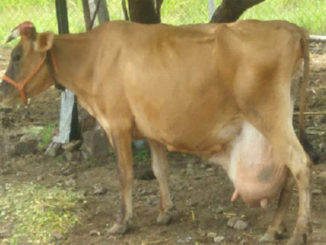
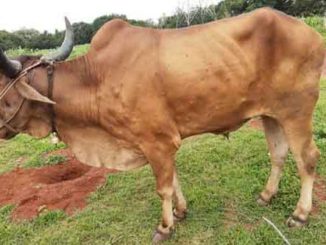

1 Trackback / Pingback